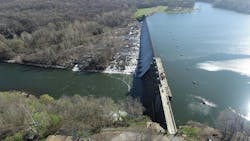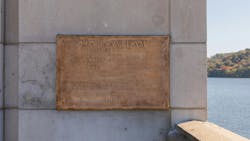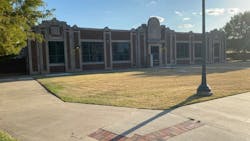Spavinaw water system celebrates 100 years of supplying water
Over 100 years ago, a group of hunters gathered in the Spavinaw Hills nearly 50 miles northeast of Tulsa, Oklahoma. While chasing game, they stumbled across the Spavinaw Creek and noticed how crystal clear the running water was. The hunters bottled up the fresh water to sip on, and even brought bottles back home to Tulsa.
Little did the hunters know they would become the influential cornerstone to clean water in the state of Oklahoma.
History of the system
Back home in Tulsa, around 1908, people got their water from the Arkansas River.
“It was terrible quality,” said Water Supply Manager for the city of Tulsa Stefanie Hunter. “When they opened a tap, mud would just come out.”
Hunter said that people would fill up their bathtubs, let the mud settle to the bottom, and use the clean water on top.
When the early residents of Tulsa bathed, they’d dry off, and then dust off.
The reports of fresh water nearly 50 miles northeast of Tulsa begged the question “how do we get the water all the way to Tulsa?”
The city began doing research and determined that they could get the water to flow from Spavinaw. The City Engineer at the time, T.C. Hughes, studied the local landscape and determined that water could flow by gravity from Spavinaw to a point just west of Catoosa, Oklahoma.
“They hired W.R. Holway,” Hunter said. "He was a 28 year old engineer who graduated from MIT. He had actually been hired by the City of Tulsa to operate the pump station at the time that was pulling water out of the Arkansas River.”
Holway recommended that the city spend no more money trying to make the Arkansas River potable.
The city determined that the gravity flow process advocated by Hughes was not only feasible, but that they could get water much closer to Tulsa than previously anticipated.
“The citizens of Tulsa approved a bond issue,” Hunter said. “Which was the largest per capita in U.S. history at the time.”
The city set up shop in Spavinaw where the Spavinaw Creek flows through and began building a dam in 1922 at a total cost of around $7.5 million. Around the same time a single flow line from Spavinaw Dam down to Tulsa was beginning construction.
“The dam essentially created Lake Spavinaw, which is about 8.5 billion gallons,” Hunter said.
The dam was completed in 1924, with the line becoming operational in November 1924.
Hunter stated that the first flow line was about 54 miles long and dropped roughly 90 feet in elevation. This has remained the primary source of water since.
Today, the line can flow 60 MGD by gravity alone, and 100 MGD with the pump stations.
The water is collected at the dam in Spavinaw, sent 54 miles down the pipeline to Tulsa where it collects in Lake Yahola, which has a capacity of roughly two billion gallons.
“At the time there wasn’t any treatment really,” Hunter said. "They were just taking the clear Spavinaw spring water and pumping it out, which was 100 times better than the Arkansas River water that they had been pumping.”
Roughly 5 years after the dam and pipeline were finished, the city completed the Mohawk Water Treating Plant in Tulsa’s Mohawk Park.
Tulsa began growing in the 1950’s. To make sure the city had enough water an additional dam was built on Spavinaw Creek.
Eucha Dam was constructed which later formed Lake Eucha. The city of Tulsa currently owns and operates both lakes and dams. A second flow line was added which runs mostly parallel to the original line.
As Tulsa continued to grow, they found the need for an additional plant. The A.B. Jewell plant was constructed in 1971 and collects water from Lake Oologah. The plant can treat up to 120 MGD.
Modern day
“Our process really starts upstream, even ahead of Eucha Lake,” Hunter said. "We’re doing source water protection. We’re making sure that we’re protecting the water that’s flowing into our lakes.”
A staff of roughly 25 people work at Lake Eucha, where people can fish, boat and camp. Lake patrol surveys the area.
At Spavinaw Lake people can also fish and boat. A small treatment plant was built at the lake to provide the citizens of Spavinaw with clean water.
The Mohawk Plant was refreshed in 1998. Additional treatment techniques were added as well as new filters. The city took note of the original design of the plant, which was a public works project, and decided to maintain the historical look of the plant throughout.
The system currently employs about 25 people on the water flow lines and 25 people at the A.B. Jewell plant.
The system totals roughly 162 miles of water flow lines – two each (four total) from Spavinaw and Oologah.
The water system has also driven industry in the area over the years, adding to the population growth and rising demand the region has seen.
“Recently, Milo’s Tea was looking for a second location,” Hunter said. "So, they did a lot of research and they chose Tulsa because of the water quality and abundance.”
What’s next
Tulsa and cities sprinkled around the area have shown growth over the years, as evidenced by the need for additional facilities. The water system has adapted, and will continue to adapt, to rising demands.
“As the population grows, I think we’re probably going to start looking at regionalization,” Hunter said. "We already supply water to at least 11 smaller cities around us. As those cities grow, we’ll probably look at some regionalization, maybe this is ‘Northeast Oklahoma Region Water Authority.’”
About the Author
Alex Cossin
Associate Editor
Alex Cossin is the associate editor for Waterworld Magazine, Wastewater Digest and Stormwater Solutions, which compose the Endeavor Business Media Water Group. Cossin graduated from Kent State University in 2018 with a Bachelor of Science in Journalism. Cossin can be reached at [email protected].





